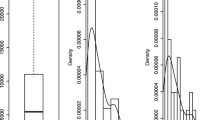Abstract
A measure called i-bar is presented, which is the inverse of the mid-range derived from data on trials-to-criterion in tasks that require practice. This measure is interpreted as a conjoint measurement scale, permitting: (a) evaluation of sensitivity of the principal performance measure (which is used to set the metric for trials to criterion); (b) evaluation of the learnability of the work method (i.e. the goodness of the software tool); (c) evaluation of the resilience of the work method. It is possible to mathematically model such order statistics using negative binomial and logistic growth equations, and derive methods for generating prediction intervals. This approach involves novel ways of thinking about statistical analysis for "practical significance." The is applicable to the study of the effects of any training or intervention, including software interventions designed to improve legacy work methods and interventions that involve creating entirely new cognitive work systems.
Chapter PDF
Similar content being viewed by others
References
Hoffman, R.R., Marx, M., Hancock, P.A.: Metrics, metrics, metrics: Negative hedonicity. IEEE: Intelligent Systems, 69–73 (March-April 2008)
Koopman, P., & Hoffman, R.R.: Work-Arounds, Make-Work, and Kludges. IEEE: Intelligent Systems, 70–75 (November/December 2003)
Goguen, J.: Towards a social, ethical theory of information. In: Bowker, G., Gasser, L., Star, L., Turner, W. (eds.) Social Science Research, Technical Systems, and Cooperative Work, pp. 27–56. Lawrence Erlbaum Associates, Hillsdale (1997)
Neville, K., Hoffman, R.R., Linde, C., Elm, W.C., Fowlkes, J.: The procurement woes revisited. IEEE Intelligent Systems, 72–75 (January/February 2008)
Rosson, M.B., Carroll, J.M.: Usability engineering: Scenario-based development of human computer interaction. Morgan Kaufman, San Francisco (2002)
Gillan, D.J., Bias, R.G.: Usability science I: Foundations. International Journal of Human-Computer Interaction 13, 351–372 (2002)
Sears, A.: Heuristic walkthroughs: finding the problems without noise. International Journal of Human-Computer Interaction 9, 213–234 (1997)
Hassenzahl, M., Monk, A.: The inference of perceived usability from beauty. Human-Computer Interaction 25, 235–260 (2010)
Nielsen, J.: Usability engineering. Academic Press, San Diego (1993)
Kantola, N., Jokela, T.: Determining high-level quantitative usability requirements: A case study. Springer, Berlin (2007)
Rubin, J., Chisnell, D.: Handbook of usability testing, 2nd edn. Wiley, Indianapolis (2008)
Hoffman, R.R., Neville, K.N., Fowlkes, J.: Using cognitive task analysis to explore issues in the procurement of intelligent decision support systems. Cognition, Technology, and Work 11, 57–70 (2009)
Roth, E.N., Eggleston, R.G.: Forging new evaluation paradigms: Beyond statistical generalization. In: Patterson, E., Miler, J. (eds.) Macrocognition Metrics and Scenarios, pp. 204–219. Ashgate, London (2010)
Ballas, J.A.: Human centered computing for tactical weather forecasting: An example of the Moving Target Rule. In: Hoffman, R.R. (ed.) Expertise out of Context: Proceedings of the Sixth International Conference on Naturalistic Decision Making, pp. 317–326. Erlbaum, Mahwah (2007)
Shepherd, A.: Hierarchical task analysis. Taylor and Francis, London (2001)
Firestone, W.A.: Alternative arguments for generalizing from data as applied to qualitative research. Educational Researcher 22, 16–23 (1993)
Public Law 111-23-Weapon Systems Acquisition Reform Act of (2009)
Woodworth, R.S.: Experimental psychology. Henry Holt and Company, New York (1938)
Hoffman, R.R.: Accelerated Proficiency and Facilitated Retention: Recommendations Based on An Integration of Research and Findings from a Working Meeting. Report on Grant FA8650-09-2-6033, U.S. Air Force Research Laboratory, Wright-Patterson AFB OH (2010)
Newell, K.M., Hancock, P.A.: Forgotten moments: Skewness and kurtosis are influential factors in inferences extrapolated from response distributions. Journal of Motor Behavior 16, 320–335 (1984)
Still, D.L., Temme, L.A.: Configuring desktop helicopter simulation for research. Aviation Space and Environmental Medicine 77, 323 (2006)
Woods, D.D.: Engineering organizational resilience to enhance safety. Presentation at the Eighth International Conference on Naturalistic Decision Making, Asilomar Conference Center, Monterey, CA (June 2007)
Siegel, S.: Non-parametric statistics for the behavioral sciences. McGraw Hill Book Company, New York (1956)
Amin, R.W., Li, K.: The EWMA maxmin tolerance limits. The International Journal of Quality and Reliability Management 17, 27–41 (2000)
Patil, G.P.: On the evaluation of the negative binomial distribution with examples. Technometrics 2, 501–505 (1960)
Hill, L.B., Rejall, A.E., Thorndike, E.L.: Practice in the case of typewriting. Pedagogical Seminary 20, 516–529 (1913)
Author information
Authors and Affiliations
Editor information
Editors and Affiliations
Rights and permissions
Copyright information
© 2011 Springer-Verlag Berlin Heidelberg
About this paper
Cite this paper
Hofman, R. (2011). Range Statistics and the Exact Modeling of Discrete Non-Gaussian Distributions on Learnability Data. In: Marcus, A. (eds) Design, User Experience, and Usability. Theory, Methods, Tools and Practice. DUXU 2011. Lecture Notes in Computer Science, vol 6770. Springer, Berlin, Heidelberg. https://doi.org/10.1007/978-3-642-21708-1_48
Download citation
DOI: https://doi.org/10.1007/978-3-642-21708-1_48
Publisher Name: Springer, Berlin, Heidelberg
Print ISBN: 978-3-642-21707-4
Online ISBN: 978-3-642-21708-1
eBook Packages: Computer ScienceComputer Science (R0)




